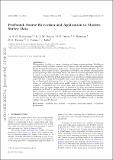Files in this item
ProFound : source extraction and application to modern survey data
Item metadata
| dc.contributor.author | Robotham, A. S. G. | |
| dc.contributor.author | Davies, L. J. M. | |
| dc.contributor.author | Driver, S. P. | |
| dc.contributor.author | Koushan, S. | |
| dc.contributor.author | Taranu, D. S. | |
| dc.contributor.author | Casura, S. | |
| dc.contributor.author | Liske, J. | |
| dc.date.accessioned | 2018-04-24T10:30:16Z | |
| dc.date.available | 2018-04-24T10:30:16Z | |
| dc.date.issued | 2018-05 | |
| dc.identifier | 252910571 | |
| dc.identifier | d4d06958-5189-432a-ab04-eaf29c3f709d | |
| dc.identifier | 85051851898 | |
| dc.identifier.citation | Robotham , A S G , Davies , L J M , Driver , S P , Koushan , S , Taranu , D S , Casura , S & Liske , J 2018 , ' ProFound : source extraction and application to modern survey data ' , Monthly Notices of the Royal Astronomical Society , vol. 476 , no. 3 , pp. 3137-3159 . https://doi.org/10.1093/mnras/sty440 | en |
| dc.identifier.issn | 0035-8711 | |
| dc.identifier.other | ArXiv: http://arxiv.org/abs/1802.00937v1 | |
| dc.identifier.uri | https://hdl.handle.net/10023/13191 | |
| dc.description | Parts of this research were conducted by the Australian Research Council Centre of Excellence for All-sky Astrophysics (CAASTRO), through project number CE110001020. | en |
| dc.description.abstract | We introduce ProFound, a source finding and image analysis package. ProFound provides methods to detect sources in noisy images, generate segmentation maps identifying the pixels belonging to each source, and measure statistics like flux, size and ellipticity. These inputs are key requirements of ProFit, our recently released galaxy profiling package, where the design aim is that these two software packages will be used in unison to semi-automatically profile large samples of galaxies. The key novel feature introduced in ProFound is that all photometry is executed on dilated segmentation maps that fully contain the identifiable flux, rather than using more traditional circular or ellipse based photometry. Also, to be less sensitive to pathological segmentation issues, the de-blending is made across saddle points in flux. We apply ProFound in a number of simulated and real world cases, and demonstrate that it behaves reasonably given its stated design goals. In particular, it offers good initial parameter estimation for ProFit, and also segmentation maps that follow the sometimes complex geometry of resolved sources, whilst capturing nearly all of the flux. A number of bulge-disc decomposition projects are already making use of the ProFound and ProFit pipeline, and adoption is being encouraged by publicly releasing the software for the open source R data analysis platform under an LGPL-3 license on GitHub (github.com/asgr/ProFound). | |
| dc.format.extent | 9393965 | |
| dc.language.iso | eng | |
| dc.relation.ispartof | Monthly Notices of the Royal Astronomical Society | en |
| dc.subject | Methods: data analysis | en |
| dc.subject | Techniques: image processing | en |
| dc.subject | Techniques: photometric | en |
| dc.subject | QC Physics | en |
| dc.subject | QA76 Computer software | en |
| dc.subject | DAS | en |
| dc.subject.lcc | QC | en |
| dc.subject.lcc | QA76 | en |
| dc.title | ProFound : source extraction and application to modern survey data | en |
| dc.type | Journal article | en |
| dc.contributor.institution | University of St Andrews. School of Physics and Astronomy | en |
| dc.identifier.doi | https://doi.org/10.1093/mnras/sty440 | |
| dc.description.status | Peer reviewed | en |
This item appears in the following Collection(s)
Items in the St Andrews Research Repository are protected by copyright, with all rights reserved, unless otherwise indicated.

